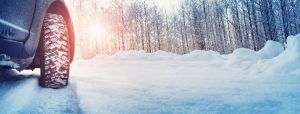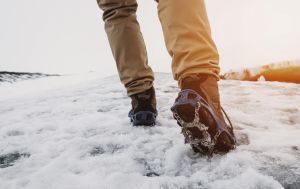December 14, 2022
December 14, 2022
Most winter safety tips can be chalked up to common sense practices, but sometimes reminders can help.
The three most culpable agents of winter misery are, as one might imagine, snow, ice and—perhaps worst of all—cold. Below, find some simple suggestions to counter each of these elements that with minimal preparation efforts can really save you some pain and frustration should you find yourself at their mercy.
 SNOW
SNOW
Snow is perhaps the most innocuous (and prettiest) of the three, but may need to be dealt with if it arrives in great amounts or is packed down into a more dangerous ice-like density.
Things to keep in your car to help with are:
• A brush for cleaning off windows and windshields.
• A well-stocked reservoir of window-washing fluid.
• A small snow shovel and traction mats or some sand/gravel if you get stuck.
ICE

Ice is a real danger in winter both to drivers and walkers, and pretty much everything you want to counteract its ninja-like assaults on your usually predictable course of motion involves adding more friction to the equation.
Things that help with this task include:
• Snow tires, tire chains and all-wheel drive.
• Yaktrax or similar slip-on traction-boosters for your shoes or boots.
• A scraper to remove ice from car windows/windshields.
• Sand, salt or gravel to sprinkle on high-traffic roads or walking paths.
Driving safely in icy conditions is extremely important. Even if you’re in a hurry, take your time—driving too fast is the number one cause of accidents on icy roads.
Other things to remember while driving in winter are:
• Don’t hit your brakes: Braking triggers slides and makes existing slides worse.
• Turn into the slide: Turn your wheels in the direction the back of the vehicle is sliding.
• Don’t panic and don’t overcorrect: overcorrecting may send the car into an unrecoverable spin.
Walkers should proceed slowly and carefully as well, and use guiderails or fences to help keep your balance if any are available. Slipping on ice usually results in a hard landing, and you could be in for anything from a broken hip to a full-on concussion.
COLD
The most insidious and least visible of our winter nemeses may also be the most dangerous. Make sure you dress warm enough (layers, hats, gloves/mittens) and limit your outdoor exposure time to safe stretches (less than 30 min. at a time if it falls below zero degrees Fahrenheit)—both frostbite and hypothermia are more common than most people think. Also, make sure to look out for both children and older friends and relatives, as they’re likely to be more susceptible to cold temperatures.
In addition, don’t let yourself be stranded thanks to car troubles; keeping the following in your vehicle will make you glad you did:
• Jumper cables in case your battery dies.
• Flashlights to help you get moving again if it’s dark out.
• A charged cell phone and automobile charger to call for help if needed.
• Blankets or sleeping bags for warmth if you’re stuck for a while.
• Road flares or reflectors to make sure other motorists can see you if you’re stalled on the side of the road.
• A basic tool kit to help you with anything you might be able to fix on your own.
• (Non-perishable) food and water (especially if you’re far out from populated areas)
Preparedness and Safety Information
- Safety and preparedness tips for extreme cold:
http://www.mass.gov/index.php/service-details/extreme-cold-safety-tips - Winter storm preparedness and safety information:
http://www.mass.gov/index.php/service-details/winter-storm-safety-tips - Safe winter driving tips:
https://www.mass.gov/service-details/safe-winter-driving-tips - Winter safety tips for pets:
https://www.mass.gov/service-details/winter-pet-safety-tips - Power outage preparedness and safety information:
http://www.mass.gov/index.php/service-details/power-outage-safety-tips

